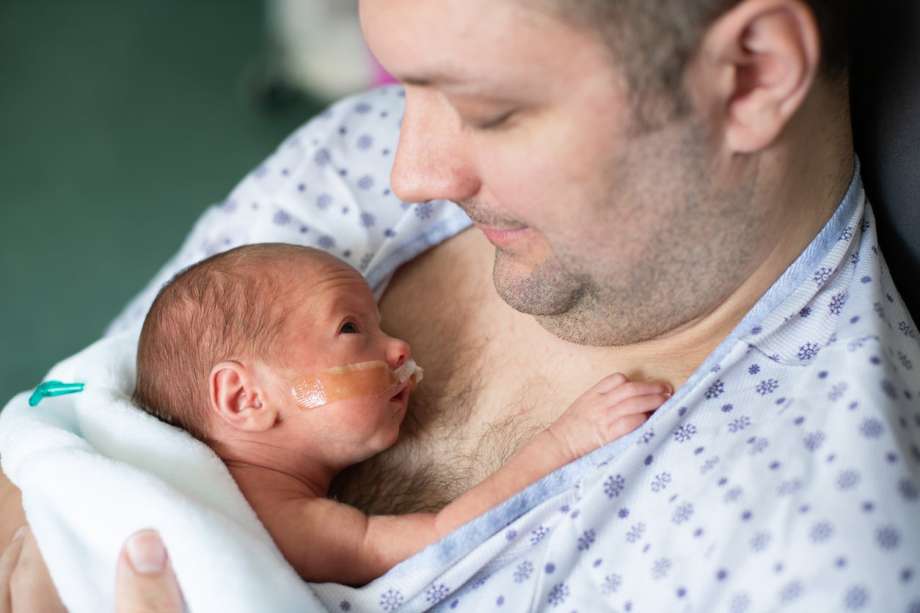Should Dads Do Skin-to-Skin?

Skin-to-skin (also called Kangaroo Care or KC) means extended skin-to-skin contact between a parent and a newborn child. In common usage, it means placing a newborn on the mother’s bare chest just after birth and holding a baby skin-to-skin for extended periods during infancy.
Some experts believe that everything else, including APGAR checks and medical interventions, should be delayed or done with the baby’s skin against the mother’s, and that postnatal skin-to-skin contact should last a minimum of an hour.
There are many documented benefits for both baby and mom. But what about dads? Are there any benefits for fathers doing skin-to-skin with their newborns?
You bet there are.
Skin-to-Skin Benefits for Newborns
Snuggling does more than simply soothe. Skin-to-skin time has numerous scientifically documented benefits for a baby’s well-being.
Helps Babies Regulate Body Temperature
In the delivery room, when a baby is exposed to air for the first time, that baby’s body temperature drops an average of two to four degrees Celsius. But simply placing the baby on the mother’s chest can help a baby to regulate its own body temperature.
One randomized controlled trial showed that babies held skin-to-skin immediately after birth were eight times less likely to develop hypothermia (Nimbalkar, 2014). In fact, skin-to-skin has been shown to be as effective at warming a baby as an incubator.
Provides Good Bacteria and Antibodies
Skin-to-skin contact with either parent exposes a baby to beneficial bacteria, which help to build the baby’s immune system.
A newborn baby’s bacteria influence the content of the mother’s milk. The bacteria transferred to a baby from a parent’s skin helps the mother to produce milk with antibodies that will help to protect the baby from later illness.
Helps Stabilize Baby’s Blood Sugar
Skin-to-skin contact has been shown to help stabilize a newborn’s blood sugar levels and improve an infant’s low blood sugar. (Stanford Medicine, 2023).
Calms Babies and Lowers Stress Levels
Transitioning from the warm, quiet womb to a cold, noisy delivery room is enough to make anyone cry. Skin-to-skin helps.
One study found that skin-to-skin greatly reduced crying just after birth. 93 percent of newborn babies in the study who were placed in cots directly after birth cried for more than one minute. Only 14 percent of babies held skin-to-skin after birth spent the first minute of their life in tears (Christensson, 1995).
And these effects continue even after birth. Babies held skin-to-skin during painful routine procedures like vaccinations and blood draws have lower stress levels and cry less. They also have lower heart rates and lower levels of stress hormones (Johnston, 2017).

Helps to Stabilize Premature Babies’ Heart Rate
Holding a premature newborn skin-to-skin directly after birth helps to stabilize the baby’s breathing and heart rate (Stanford Medicine, 2023).
Promotes Healthy Brain Development
One study showed that premature babies who received Kangaroo Care for one hour a day for the first 14 days of life scored higher on cognitive tests and slept better as many as ten years later (Marshall, 2020). Another study found that KC promoted healthy levels of brain activity in all infants in the study (Marshall, 2020).
Promotes Breastfeeding
Babies are hard-wired to immediately look for the nipple after birth. If the mother’s breasts are unobscured by clothing, this becomes faster and easier. Skin-to-skin contact has been shown to decrease the time it takes pre-term babies to begin breastfeeding (Mekonnen, 2019).
Decreases Neonatal Mortality and Morbidity
Many studies have shown that skin-to-skin contact reduces the incidence of neonatal mortality (death) and neonatal morbidity (health conditions) (Mekonnen, 2019).
Skin-to-Skin Benefits for Both Parents
Moms get a lot of benefits from going skin-to-skin with their babies. Many dads already know how important a father’s closeness can be. But science is just starting to explore the importance of skin-to-skin contact with Dad, too.
May Lower Risk of Postpartum Depression
Postpartum depression is a potentially serious condition that affects as many as one in seven women.
A 2012 study in the Journal of Obstetric, Gynecological, and Neonatal Nursing showed that women who participated in five hours of skin-to-skin contact (SSC) per day with their infants for the first week, and two hours per day until the infants were one month old, had lower scores on the study’s depression scale, and measurably lower levels of cortisol (the stress hormone) (Bigelow, 2012).
Increases Dad’s Attachment to Baby
Another study showed that fathers who held their babies skin-to-skin for a minimum of 15 minutes on the day of their baby’s birth and for each of three days after that, felt a stronger attachment to their babies than dads who held their clothed babies (Chen, 2017).
Promotes Baby’s Attachment to Dad
Attachment goes both ways. Cuddling your little one skin-to-skin has been shown to increase a child’s feeling of attachment to their Dad.
Boosts Oxytocin and Cortisol
Skin-to-skin contact has been shown to cause the release of Oxytocin and Cortisol in both moms and dads.
Oxytocin is known as the “love hormone,” and increased Oxytocin levels mean an increased feeling of attachment between parent and child.
To wit, a 2018 study found that dads whose cortisol levels rose when they first held their babies were more involved in caring for their babies even months later (Kuo, 2018).
Improves Mood After a C-Section (for Dads Too!)
Can you do skin-to-skin contact after a Cesarean section? Yes, you can, with proper protection of the mother’s body. And it’s good for both mom and baby.
A study published in the Journal of American/Maternal Nursing found that when mothers who had undergone a C-section held their babies skin-to-skin following birth, it resulted in lower reported pain levels for moms, and higher satisfaction with the birthing process (Sundin, 2015).
Skin-to-skin with Dad after a C-section is also good for babies. According to a 2019 study published in the Journal of Obstetric, Gynecological, and Neonatal Nursing, babies held skin-to-skin with their fathers following a Cesarean section had more stable heart rates and forehead temperatures, cried for less time, and started feeding earlier.
The fathers in the study also scored lower for anxiety and depression, and higher for “role attainment,” that is, attachment to the baby over time (Huang, 2019).
Skin-to-Skin, Step-by-Step

So, how do you do skin-to-skin? It’s pretty easy.
After birth, your doctor, nurse, or midwife will dry the baby and place it on the mother’s chest, often covering the baby with a cloth.
Dad can come prepared with a shirt that buttons down or opens easily. Make sure that your birthing team knows that skin-to-skin with both parents is on the plan.
After your baby comes home, both parents are welcome to hold their baby skin to skin as often as they like, for as long as they like.
If your baby has medical concerns, or mom has undergone a C-section, it’s important to follow the instructions of your medical team regarding lifting, positioning, and holding your baby.
If your baby is in the NICU (neonatal intensive care unit), you may be able to do skin-to-skin there, also. Consult with your medical team to determine the best way to do this.
Make Skin-to-Skin With Dad Part of Your Birth Plan
Today’s dads are more involved than ever with their babies, and this is to everyone’s benefit. Skin-to-skin is good for everyone—so make sure your birthing team is prepared to assist both parents with this important step.

